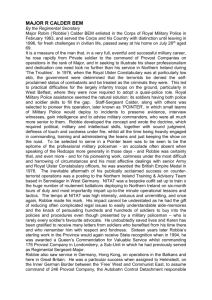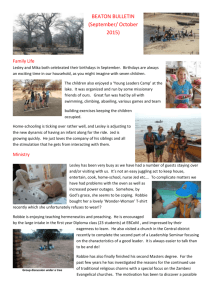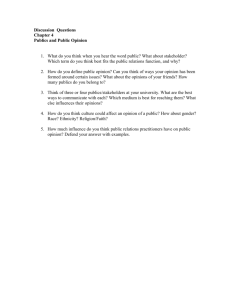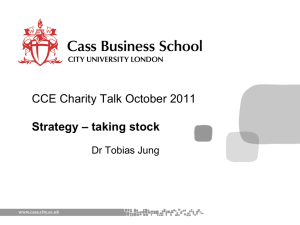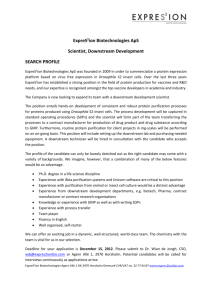Species Matter: An Ethics of Vulnerability for Adaptation
advertisement
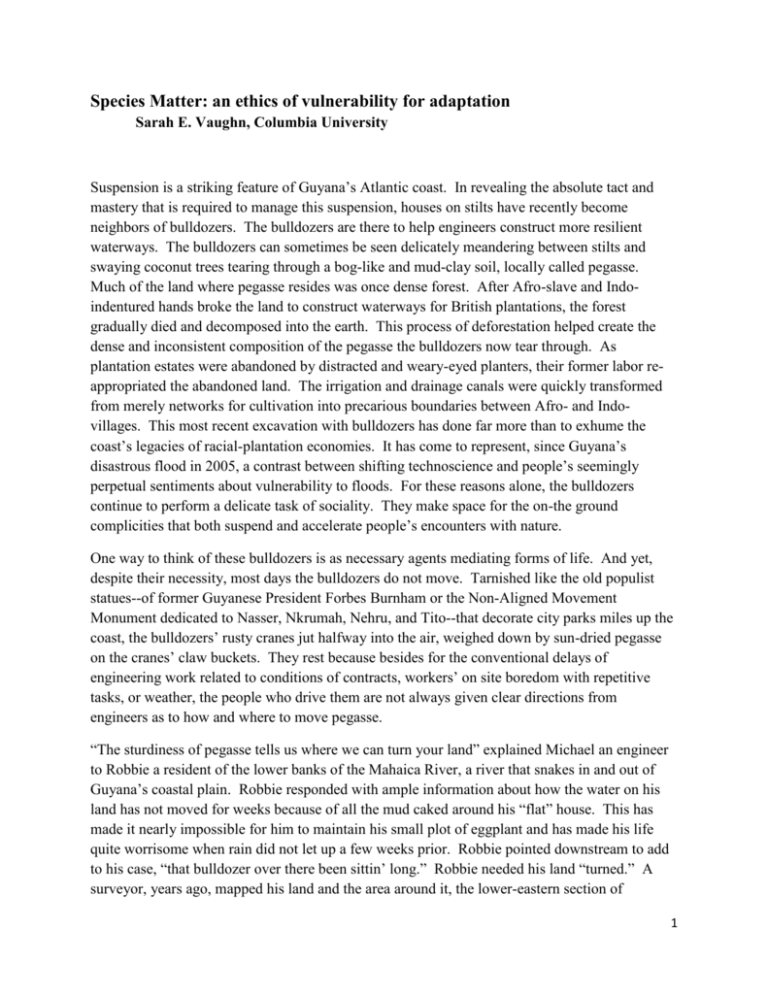
Species Matter: an ethics of vulnerability for adaptation Sarah E. Vaughn, Columbia University Suspension is a striking feature of Guyana’s Atlantic coast. In revealing the absolute tact and mastery that is required to manage this suspension, houses on stilts have recently become neighbors of bulldozers. The bulldozers are there to help engineers construct more resilient waterways. The bulldozers can sometimes be seen delicately meandering between stilts and swaying coconut trees tearing through a bog-like and mud-clay soil, locally called pegasse. Much of the land where pegasse resides was once dense forest. After Afro-slave and Indoindentured hands broke the land to construct waterways for British plantations, the forest gradually died and decomposed into the earth. This process of deforestation helped create the dense and inconsistent composition of the pegasse the bulldozers now tear through. As plantation estates were abandoned by distracted and weary-eyed planters, their former labor reappropriated the abandoned land. The irrigation and drainage canals were quickly transformed from merely networks for cultivation into precarious boundaries between Afro- and Indovillages. This most recent excavation with bulldozers has done far more than to exhume the coast’s legacies of racial-plantation economies. It has come to represent, since Guyana’s disastrous flood in 2005, a contrast between shifting technoscience and people’s seemingly perpetual sentiments about vulnerability to floods. For these reasons alone, the bulldozers continue to perform a delicate task of sociality. They make space for the on-the ground complicities that both suspend and accelerate people’s encounters with nature. One way to think of these bulldozers is as necessary agents mediating forms of life. And yet, despite their necessity, most days the bulldozers do not move. Tarnished like the old populist statues--of former Guyanese President Forbes Burnham or the Non-Aligned Movement Monument dedicated to Nasser, Nkrumah, Nehru, and Tito--that decorate city parks miles up the coast, the bulldozers’ rusty cranes jut halfway into the air, weighed down by sun-dried pegasse on the cranes’ claw buckets. They rest because besides for the conventional delays of engineering work related to conditions of contracts, workers’ on site boredom with repetitive tasks, or weather, the people who drive them are not always given clear directions from engineers as to how and where to move pegasse. “The sturdiness of pegasse tells us where we can turn your land” explained Michael an engineer to Robbie a resident of the lower banks of the Mahaica River, a river that snakes in and out of Guyana’s coastal plain. Robbie responded with ample information about how the water on his land has not moved for weeks because of all the mud caked around his “flat” house. This has made it nearly impossible for him to maintain his small plot of eggplant and has made his life quite worrisome when rain did not let up a few weeks prior. Robbie pointed downstream to add to his case, “that bulldozer over there been sittin’ long.” Robbie needed his land “turned.” A surveyor, years ago, mapped his land and the area around it, the lower-eastern section of 1 Mahaica and the farthest point on the frontier of an incomplete agricultural scheme. Robbie has been in waiting to have his land excavated and the river embankment completed. The homes and small agricultural plots on this side of the Mahaica are cut-off from the main irrigation and drainage canals. This means that Robbie’s land does not receive water to irrigate crops or drainage when rainfall comes. With a bulldozer revving-up its engine in the background, Michael yelled to Robbie to “feel” the soil and to tell him where it sinks and where it rises. That afternoon Michael collected measurements and anecdotal accounts of how the water falls off the land and where and what would be the fastest method to dig a canal that would connect Robbie’s land perpendicular to the Mahaica River and to the existing canal some miles south. On our way back into town Michael scolded me for not asking Robbie more questions. “You should have asked more. You wanted to know…how they live.” Speeding along a bumpy back road in a four-by-four, we passed construction site after construction site of partially renovated kokers1 surrounded by mud that spilled into oncoming traffic. Michael went on to explain that it was actually OK that I did not ask more questions because Robbie could not tell me what I wanted to know. If I wanted to hear the real story, he told me, I would have to go back on my own time and speak to Robbie’s neighbor. She is an elderly woman who has lived in the area longer than anyone else and has seen mud and floods, and so knows better than to try and farm. Eventually our conversation turned from mud to politics. Michael jovially asked what I thought about a local political pundit who was recently ambushed on a local city street in broad daylight by a group of men who threw a bucket of manure on his head. I answered with an obligatory appeal to the event’s comedic gesture but added that truthfully, I was a bit confused as to what it was supposed to signify. Michael explained that, obviously, it was a political thing--“PPP vs. PNC.”2 As a well-seasoned engineer and graduate of a state-sponsored degree program, Michael noted that “thing” as generational. Lifting his hand from the steering wheel, he gestured, “I can count on my hand how many of those old guys [at work] aren’t PPP”. As part of a younger generation, he insisted that he does not “get caught up” in such things. Complicating his explanation even further, he told me how his mother is from the bush and that his father met her there while working for a milling firm. But Michael did not know the bush himself because as he explained, he grew-up in the city away from his mother’s family, which did not care too much for their seemingly root-less and ‘black’ son-in-law. “You know, me being dougla,3 I understand both, [PPP or PNC] doesn’t matter.” Vigorously pressing on the gas pedal, Michael clarified his position, to say that his job has been good to him. So long as he completes his work on time, there is no hassle. 1 Usually a wooden or concrete structure used to control the distribution and flow of water through canals. The PPPC (People’s Progressive Party Civic) and the PNCR (People’s National Congress Reform) are two national political parties in Guyana that are historically identified by Guyanese as raced-based parties, with the PPP representing Indo-Guyanese and the PNC representing Afro-Guyanese (and other racial populations such as Amerindians and Portuguese), respectively. 3 A slang word used to identify mixed-raced people usually exclusively of Indo-/Afro-Guyanese decent. 2 2 That afternoon we had to get back to Michael’s office before his boss went home for the evening. Michael needed to brief him about Robbie. I told Michael that I presumed that part of his report would include comparing Robbie’s accounts of pegasse with the office’s existing files on soil compositions. “No”, explained Michael. He insisted that comparative soil work has already been done and at this stage, such things are extraneous variables that apparently, to this day, have not directly helped Robbie’s cause anyway. The filed notes, Michael explained, would later inform the new blueprints of Robbie’s land and the surrounding frontier that is to be turned and given waterways. I assumed that all the talk I overheard between Robbie and Michael about “feeling” pegasse and its shifting composition would have at least entertained lip-service to the laborious and ambiguous demands of corrective soil surveys to “really” find out what minerals and microbes compose this hard to manage matter. But it did not. Michael and Robbie would just have to make do with feelings. “Pegasse is pegasse…that’s not my specialty,” mumbled Michael as we headed into town. Following Michael, I want to consider how soil is a way to understand cross-species encounters and the overlap between racial society and nature in Guyana. Soil and the technologies used to control it, following the work of anthropologist Stefan Helmreich (2009), are biotechnologies: assemblages of technological and scientific matter that collapse the distinction between nature, species, and culture around the life cycles of biological organisms (Rabinow 1992). On the one hand, biotechnologies involve scientific practices dedicated to abstracting and quantifying life. On the other hand, the products of these calculations can also be classified as emergent social imperatives of varying institutions, cultural practices, and people. In short, the scientific practices, institutions, and people dedicated to biotechnologies are seemingly novel because they inform a particular way of communicating issues about “life” to the public. For my purposes here, biotechnologies inform one way in which to understand how soil and social debates about climate change and floods circulate in the Guyanese public sphere. The labor and epistemic objectives of biotechnologies arguably echo John Dewey’s analysis of the evolutionary sciences and his assessments of Darwin’s The Origin of Species. “[After Darwin] natural science is forced by its own development to abandon the assumption of fixity and to recognize that [life] is actually ‘universal’ in process” (1965). Life is not about “biological reductionism” but about varying responses to ‘worldly’ events. Anthropologist Eduardo Kohn (2007) phrases Dewey’s pragmatism in more lucid terms, “[this view of biological-social life] offers [a way] to look to a context beyond the uniquely human…and [that is] a life that is also changed by the distinctive ways in which humans live it” (3-4). To understand and to take seriously these claims about cross-species encounters inform the production of human sociality it might be helpful to begin by considering: what sorts of claims rub-up against this view about the links between the lifeworlds of humans and nonhuman species? The first claim that comes to my mind, is one made particularly among animal rights activists, that forms of human life and nonhuman animal life do not necessarily carry the same “rights” 3 even though they may carry the same “value” within a given scientific or laboratory context. So the argument goes, any sort of experimental work that does not recognize the different types of social value that can be attributed to human and nonhuman animals are really only recognizing biological “life” as a commodity as opposed to recognizing biological life as having a “moralethical” capacity. This claim about the distinction between human life and that of nonhuman life I want to suggest, can offer us much more than a rights-oriented view of politics, and does in fact take on special significance for a political understanding about modes of ‘being’ in the everyday. Take for example, John Lovelock’s Gaia Theory, which views life and the environment as a tightly coupled single system, linking chemical discrepancies in the earth’s atmosphere to the life cycles of biological organisms (1979). Lovelock argues that the earth’s atmospheric chemistry, mean global temperature, and oceans’ salinity are regulated by the metabolism of the sum of earth’s life. Each process comes into symbiotic associations that become absolutely required to recycle waste, and so keep the earth reproducing cells at the “lowest” organizational level. The result of these interrelated processes is that overtime the earth becomes increasingly specialized and differentiated. Lynn Margulis has followed this view in her discussions of the significance of microbes as the basic component for the identification of all “species” life on earth (Margulis and Sagan 2002). The implications of these views are that if the earth’s environment is selfregulatory, in effect, the Gaia Theory calls on every human on the planet to recognize that they are dependent on “other” life forms to adapt to climate change. The important point to recognize, for my purposes here, is to understand how and why it is that for some people biotechnologies make sense to constitute a more “livable” world and for others it makes very little sense at all (Viveriros de Castro 2004) in the face of events related to climate change. To not interrogate these views side-by-side, may privilege an idealized image of “life” as opposed to the socially embedded relations between humans and other species that can play out across space-time. This point leads me in the direction of a second problematic that informs contemporary biotechnologies and climate change. If one of the primary objectives of scientific communities developing biotechnologies is to formulate “institutional agreements” about “life regulation” then this immediately puts into question: What happens when scientists, policy makers, nations, governing institutions, and consumers of biotechnologies fail to agree about what counts as life? In recent years, there have been a number of critical efforts within the social sciences examining how biotechnologies influence the emergence of novel institutions, political, and market economies that put into flux or siphon off the formation of normative identity politics for some populations more than others. In this sense, we can see how ethical contentions over biotechnologies creatively rework institutional agreements about life regulation over time, making room for the political recognition of and for a politics about the relationship between technoscience and sociocultural plurality. However, in the backdrop of climate change, the fundamental epistemological dilemma scientists face is so much more than a question of 4 ‘plurality.’ Their work is also invested in recognizing that they are explicitly in the business of producing technologies that are to help manage forms of life that are not necessarily projected to exist in the same type of social-biological ecosystem into the near and distant future. In recognizing this point about the environment’s uncertain longevity, it is productive to analyze how humans and nonhuman species socially coexist with each other within and through shifting modes of encounters across space-time. But simply recognizing the role of biotechnologies in affecting cross-species encounters overtime does not get very close in the way of responding to the plethora of ethical problems that biotechnologies do in fact incite in everyday life. In appreciating this view, points me in the direction of asking: What types of publics do biotechnologies mobilize? And why do these publics matter? I propose that the biotechnologies that are emerging within the context of climate science incite what I call “vulnerable publics”--communities wedded to a social imaginary about how species co-manage vulnerability to climate across space-time. Vulnerable publics matter for three reasons. One, vulnerable publics bring into view that vulnerability is as much about a condition of defenselessness as it is about openness to others. Two, vulnerable publics bring into sharp focus that the political conditions for securing any sort of life is inherently unstable. Three, vulnerable publics demonstrate that the formation of community is built around something much more than just the trajectory of any immediate event. My concern throughout this paper, about the relationship between publics, environment, and biotechnologies, has pointed me in the direction of a central problematic related to governing climate change: how is it that states and transnational organizations lean on imaginaries about “vulnerability” to defer the problems that environmental crises posed to the “quality” life in the first place? Revisiting studies critical of environmental development gets me close in the way of answering this question. They illustrate how “development” is a temporalizing discourse and practice that valorizes specific forms of culture, commodification, and politics that shore-up the exploitation of nature to make capitalism sustainable into the distant future. The above critique is still relevant within the context of climate adaptation because it makes clear how a notion of adaptation does (and sometimes does not) circulate to effectively index environmental development across varying social contexts. The effect of which, makes clear that the varying planetary engagements around climate adaptation do not signal so much as critique, to “make right” development’s shortcomings. As much as it makes clear that these engagements draw attention to how people come to imagine and naturalize distinctions between their survival relative to other species. Works Cited: Dewey, John. 1965. The Influence of Darwin on Philosophy. Bloomington: Indiana University Press. 5 Helmreich, Stefan. 2009. Alien Ocean: Anthropological Voyages in Microbial Seas. Berkeley: University of California Press. Kohn, Eduardo. 2007. “How dogs dream: Amazonian natures and the politics of transspecies engagement.” American Ethnologist 34(1): 3-24. Lovelock, John E. 1979. Gaia: A New Look at Life on Earth. Oxford: Oxford University Press. Margulis, Lynn and Dorion Sagan. 2002. Acquiring Genomes: A Theory of the Origins of Species. New York: Basic Books. Rabinow, Paul. 1992. “Artificiality to Enlightenment: From Sciobiology to Biosociality.” In Incorporations. ed. Jonathan Crary and Sanford Kwinter. New York: Zone. Viveiros de Castro, Eduardo. 1998. “Cosmological Deixi and Amerindian Perspectivism.” Journal of the Royal Anthropological Institute (n.s.) 4(3): 469-88. 6
